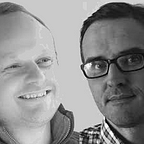The Haves and Have nots (and Big Sam)
The difference in how the rich and poor spend their money
A couple of weeks ago the Office for National Statistics (ONS) released over fifty data tables on family spending for 2016/17, broken down by household and area characteristics as well as the types of spending. The data provides a rich insight into the spending habits of UK households.
The media reports on the data release focused on the return of average household income to the pre-crash level of 2008, how much the 65+ are now spending on recreation and culture, or the amount spent on red wine and package holidays.
Most articles seemed to ignore the detailed data available on the difference in the type of spending between the richest and poorest households.
The graphics below compare the spending habits between the highest and lowest spending households (the highest and lowest deciles based on the disposable income). We start by dividing the graph between the two groups with two separate axis.
We then add circles which show the percentage of total expenditure spent on goods and services. Each dot specifies a different category of spend.
Finally, by adding the orange lines we can see whether households are spending more or less compared to each other. The final “slope chart” is below.
Although a lot of the househould spend is similar, clearly the poorest households are spending proportionally more on housing, power and food. Less on transport (perhaps walking more), restaurants, and other expenditure (which is holiday spending. Not needed when you can’t afford a holiday.) The spend on alcohol is higher for poorest households, but not as much as probably would be assumed by the average Dail Mail reader.
It makes sense that the goods and services that are ‘essential’ are those that the poorest households are having to spend a greater proportion of their money on. A limited budget can only go so far.
The graph below breaks the spending down even further. The obvious standout difference is the proportionally higher amounts spent on food, electricity and gas and rent by the poorest households.
A report by the Centre for Economics and Business Research defined households who have to spend more than 10% of their income on food as being in food poverty. (Hard to Swallow: The Facts about Food Poverty, CEBR 2013)
So despite the high proportion of spending on food, the poorest households might not be spending enough on their meals to meet their needs. This is mainly as food prices have increased at a faster rate than other costs in the last few years, and as wage rises have stagnated.
And other essentials such as power and rent are more of a fixed cost and have to be paid. For example the poorest pay £9.60 and £7.70 respectively for Electricity and Gas, while the richest pay £13.60 for each. That’s 8.1% of the budget of the poorest households, in comparison to just 2.4% of the richest. With these fixed costs stretched over several areas is it any wonder that something has to give?
So it should be no surprise that the Trussell Trust Network have 428 food banks across the UK. The Trussell Trust gave out 586,907 three-day emergency food supplies between 1 April and 30 September 2017, a rise of 67,565 on the previous year.
As one commentator rightly puts it,
“It’s extremely depressing that a country of this magnitude, and where it thinks it lies in itself, can allow so many foodbanks to be operating in this country.”
and it’s not only continuing but,
“ growing at a rapid pace where people who are in work, not just on benefits, can’t afford to live at a decent level and have to go to foodbanks to feed themselves and their children.”
The commentator who voiced his anger of this national scandal was Sam Alladyce. Manager of Everton Football Club. Everton has some of the poorest areas in Europe and the club encourage supporters to donate to the local food bank.
It has come to something when a high profile football manager feels the need to use his pre-game press conference to point out this national scandal to the (football) public.
“ Big Sam” is known for sending out teams that have a plan, and are pragmatic. They may be no-nonsense and boring, but usually get results. Perhaps Alladyce would probably make a better fist of sorting welfare than the current government. He certainly has shown more compassion.
Further Exploration
If you’re interested in the data analysed in this article we’ve published an exploratory visualisation of the spending by the richest and poorest across the UK. Explore it here.
Methodology & Sources
Rob used Easymorph to deal with the dreadful ONS spreadsheet. The ONS spreadsheets are designed to be read, not analysed, so they are full of weird line breaks, column headings over a number of rows and random spacing to make it easier to be read.
He then used Tableau to create the slope graphs, which was the easiest bit, and spent ages shorterning label names and repositioning them so they could be easily read without interactive tooltips. The graph design is based on one seen in the Financial Times a couple of years ago, possibly by Alan Smith.
And we used figures in the text, because sometimes text is as powerful as a graphic.
